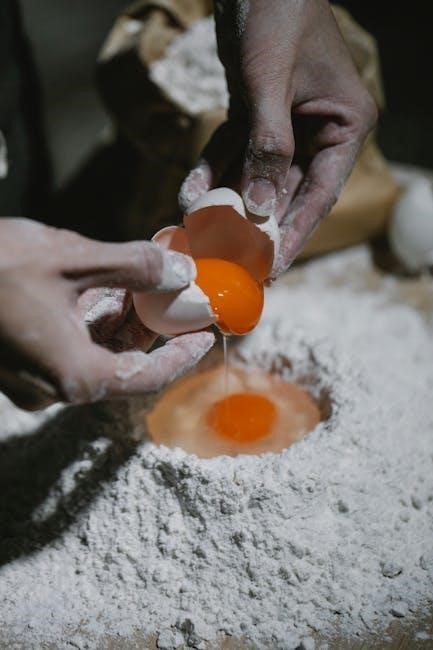Thermite is a pyrotechnic composition of metal and metal oxide powders, famously aluminum and iron oxide, producing intense heat and light upon ignition. Used in fireworks and metal casting, its reaction requires precise ratios and high-temperature ignition, emphasizing safety and legal compliance to handle responsibly.
1.1 What is Thermite?
Thermite is a pyrotechnic composition of metal and metal oxide powders, most commonly aluminum and iron oxide. When ignited, it undergoes an exothermic reaction, producing molten iron and releasing intense heat and light. This reaction is highly energetic, with temperatures reaching up to 2,500°C. Thermite is widely used in welding, cutting, and fireworks due to its ability to generate extreme heat. It is also historically significant, having been used in military applications such as incendiary weapons. The mixture is stable at room temperature but requires a high-temperature ignition source to initiate the reaction.
1.2 Historical Background and Applications
Thermite was first discovered in 1893 by German chemist Hans Goldschmidt. Originally used for welding railroad tracks, its applications expanded to include cutting metals, fireworks, and military uses. In World War II, thermite incendiary bombs caused significant damage. Today, it’s used in metal casting, demolition, and rescue operations. Its unique properties make it versatile, but its potential for misuse has led to strict regulations. Historical use highlights its dual role as a tool for construction and destruction, emphasizing the need for responsible handling and legal compliance.
Components of Thermite
Thermite primarily consists of aluminum powder and iron oxide, with magnesium or sparklers used for ignition. These components react exothermically, producing intense heat and molten iron.
2.1 Iron Oxide (Rust)
Iron oxide, commonly known as rust, is a critical component in thermite. It acts as the metal oxide that reacts with aluminum powder to produce molten iron and release significant heat. Typically, red iron oxide (Fe₂O₃) is preferred due to its stability and reactivity. The quality and purity of the iron oxide directly impact the reaction’s efficiency. Proper handling and storage are essential to maintain its effectiveness and safety. Iron oxide is readily available and often used in industrial applications, making it accessible for thermite preparation.
2.2 Aluminum Powder
Aluminum powder serves as the fuel in the thermite reaction, reacting with iron oxide to release intense heat and light. It is typically finely ground to maximize surface area for reactivity. The powder’s purity and particle size significantly affect the reaction’s efficiency. Aluminum powder is commonly sourced from scrap metal or commercial suppliers. Proper storage in a cool, dry place is essential to prevent oxidation and moisture exposure, which can degrade its effectiveness. Handling aluminum powder requires care to avoid inhalation and ignition risks, emphasizing the importance of safety precautions.
2.3 Magnesium Strip or Sparkler for Ignition
Magnesium strips or sparklers are commonly used to ignite thermite mixtures due to their ability to produce high temperatures when burned. The magnesium strip is typically lit with a flame source, such as a Bunsen burner or lighter, and then placed in contact with the thermite mixture. Sparklers, often used in fireworks, provide a controlled ignition point, ensuring the reaction starts efficiently. Proper handling of magnesium is crucial to avoid accidental ignition, and caution must be exercised to maintain safety during the ignition process.
Safety Precautions
Handle thermite components with care, avoiding sparks and open flames. Keep the mixture away from flammable materials and ensure a fire extinguisher is nearby. Wear protective gear, including gloves and goggles, and operate in a well-ventilated area. Follow all local laws and regulations regarding explosive mixtures to minimize risks and ensure safe practices.
3.1 Handling Reactive Chemicals
When handling thermite components, exercise extreme caution due to their reactive nature. Store iron oxide, aluminum powder, and magnesium strips in sealed containers to prevent accidental ignition. Avoid inhalation of powders, as they can cause respiratory issues. Wear protective gloves and eyewear to minimize skin and eye exposure; Ensure all preparations are done in a well-ventilated area, away from open flames or sparks. Always follow proper safety protocols to prevent unintended reactions, and consult local regulations for handling explosive materials responsibly.
3;2 Protective Equipment
When preparing or handling thermite, wear appropriate protective equipment to minimize risks. This includes heat-resistant gloves, safety goggles, and a face shield to protect against sparks and molten metal. A lab coat or fire-resistant apron is recommended to prevent skin exposure. Additionally, a dust mask should be worn when mixing powders to avoid inhalation. Ensure long sleeves and pants are worn, and keep loose clothing tied back. Closed-toe shoes and a well-ventilated workspace are essential. Keep a fire extinguisher nearby and avoid working in confined areas without proper airflow.
3.4 Legal Considerations and Risks
Creating or possessing thermite may be subject to legal restrictions depending on local laws, as it can be classified as an explosive or hazardous material. Misuse or improper storage can lead to legal consequences, including fines or imprisonment. Authorities often monitor activities involving thermite due to its potential for misuse in illegal activities. Sharing instructions or using smart devices to disseminate such information, as seen in legal cases, can result in severe penalties. Always ensure compliance with local regulations and handle thermite responsibly to avoid legal repercussions.

Preparation of Thermite Mixture
Thermite mixture preparation involves accurately measuring and mixing iron oxide and aluminum powder in a 27:80 ratio. Use a scale for precise measurements, typically in grams or ounces. Mix thoroughly using a mortar and pestle or by stirring in a bowl to ensure uniformity. Wear protective gear like gloves and goggles. The mixture is then ready for ignition, often using a magnesium strip or sparkler. Proper setup and safety precautions are essential to handle the exothermic reaction safely.
4.1 Measuring the Components
Accurate measurement of thermite components is crucial for safety and reaction efficiency. Use a digital scale to weigh iron oxide and aluminum powder precisely. The typical ratio is 3 parts iron oxide to 1 part aluminum by weight. For a small batch, measure 3 ounces of iron oxide and 1 ounce of aluminum powder. Avoid approximations, as incorrect proportions can lead to inconsistent reactions. Always measure in a well-ventilated area, wearing gloves and goggles. Proper measurement ensures the mixture ignites reliably and burns efficiently. Double-check weights before proceeding.
4.2 Mixing Iron Oxide and Aluminum Powder
Combine iron oxide and aluminum powder in a clean, dry mortar. Add the iron oxide first, then gradually incorporate the aluminum powder. Use a pestle to grind the mixture thoroughly, ensuring an even distribution. Avoid using metal tools to prevent contamination. Sift the mixture into a separate container to remove lumps. This step is critical for a consistent reaction. Wear protective gloves and eyewear, and work in a well-ventilated area to avoid inhaling fine particles. Proper mixing ensures the thermite burns efficiently and safely.
4.3 Creating the Reaction Mixture
After mixing iron oxide and aluminum powder, transfer the blend to a heat-resistant container. Shape the mixture into a mound or pour it into a mold. Insert a magnesium strip or sparkler into the center, ensuring it protrudes above the surface. This setup ensures the ignition source is in direct contact with the thermite. Avoid compacting the mixture excessively, as this can inhibit the reaction. The final mixture should be stable but ready to react once ignited. Always handle with care to prevent accidental activation.
Ignition Process
Ignition requires a high-temperature source, such as a magnesium strip or sparkler. Insert the ignition material into the thermite mixture and light it carefully. The reaction begins rapidly, producing intense heat and light. Always maintain a safe distance and follow proper safety protocols to avoid accidents.
5.1 Using Magnesium Ribbon
A magnesium ribbon is a reliable ignition source for thermite. It burns at a high temperature when lit with a flame, such as from a Bunsen burner. Once ignited, the ribbon should be placed in contact with the thermite mixture. The magnesium burns fiercely, providing the heat needed to initiate the exothermic reaction. Proper handling and precautions are essential to ensure safety, as the reaction starts almost immediately once the magnesium ignites the mixture. Always use protective gear and maintain a safe distance.
5.2 Sparkler Ignition Method
A sparkler can be used to ignite thermite by embedding it into the mixture. Insert the sparkler upright, ensuring about 34 cm is buried below the surface, with the rest extending above. This setup allows the sparkler to ignite the thermite evenly. Light the exposed portion of the sparkler and step back immediately. The sparkler will burn down and ignite the thermite, producing intense heat and light. This method is effective and commonly used due to its reliability and ease of setup.
5.3 High-Temperature Ignition Sources
High-temperature ignition sources are essential for initiating the thermite reaction. A magnesium ribbon, when ignited with a Bunsen burner, can serve as a reliable ignition source. Alternatively, potassium permanganate mixed with glycerin can create sparks and flames, initiating the reaction. These methods ensure the high heat required to start the exothermic process. Always handle such ignition sources with caution, wearing protective gear and maintaining a safe distance from the reaction area to avoid accidents.

The Chemical Reaction
The thermite reaction involves aluminum and iron oxide, producing molten iron and alumina. It is highly exothermic, releasing intense heat and light, reaching temperatures above 2,500°C.
6.1 Exothermic Reaction Details
The thermite reaction is a highly exothermic process where aluminum reacts with iron oxide, releasing significant heat and light. This reaction generates temperatures exceeding 2,500°C, producing molten iron and alumina. The aluminum acts as a reducing agent, while iron oxide serves as the oxidizer. The intense heat released makes the reaction self-sustaining once initiated, with the products forming a slag of alumina and molten iron. This reaction is widely utilized in applications requiring high temperatures, such as welding and pyrotechnics.
6.2 Products of the Reaction
The thermite reaction produces molten iron and alumina (aluminum oxide) slag. The reaction releases a significant amount of energy, with the molten iron reaching temperatures around 2,500°C. The alumina slag, being less dense, floats on the molten iron, forming a protective layer. These products are utilized in various industrial and pyrotechnic applications, showcasing the reaction’s practical uses despite its dangerous nature. The extreme heat generated makes the reaction highly efficient for specific processes, such as metal welding and cutting.
6.3 Heat and Light Generation
The thermite reaction generates intense heat and light, producing temperatures up to 2,500°C. This exothermic process releases a brilliant flash of light, making it ideal for pyrotechnic displays. The reaction’s heat is harnessed in industrial applications like welding and metal cutting. The extreme thermal output creates a brief but highly concentrated energy release, making it both powerful and visually striking. This characteristic is why thermite is often used in fireworks and specialized industrial processes requiring precise, high-temperature applications.
Safety Measures During the Reaction
Use sand-filled buckets for containment and maintain a safe distance. Keep fire extinguishers nearby and avoid inhaling fumes. Ensure proper ventilation and have emergency procedures ready.
7.1 Containment and Isolation
Containment is critical to prevent the thermite reaction from spreading uncontrollably. Use a sand-filled bucket or a heat-resistant container to isolate the reaction. Ensure the setup is away from flammable materials.sand should be deep enough to absorb heat and sparks. The container must be placed in an open, well-ventilated area to prevent the accumulation of harmful fumes. Isolation also involves keeping bystanders at a safe distance to avoid exposure to extreme heat and molten metal. Proper containment helps mitigate risks and ensures a controlled reaction environment.
7.2 Fire Safety and Extinguishers
Fire safety is paramount when working with thermite. Keep a fire extinguisher rated for metal fires nearby, as standard extinguishers may not suffice. Water can exacerbate the situation by splashing molten metal. Ensure the area is clear of flammable materials. Sand can be used to smother smaller fires. Have a bucket of dry sand readily available. Maintain a safe distance and be prepared for emergencies. Always have emergency contact numbers accessible. Proper fire safety measures are essential to prevent accidents and control potential fires effectively during the reaction.
7.3 Emergency Procedures
In case of an unexpected thermite reaction, evacuate the area immediately and call emergency services. Isolate the site to prevent further risks. Use dry sand or specialized extinguishers for metal fires if safe to do so. Never use water, as it can aggravate the situation. Provide first aid for burns by cooling affected areas with clean water. Ensure all bystanders are at a safe distance. Keep emergency contact numbers handy and have a contingency plan in place to address accidents swiftly and effectively, minimizing potential harm and property damage.

Legal and Ethical Considerations
Creating thermite is subject to strict laws due to its potential misuse. Ensure compliance with local regulations and handle responsibly to avoid legal consequences and ethical dilemmas.
8.1 Laws Regarding Explosive Mixtures
Thermite is classified as an explosive mixture in many jurisdictions, subject to strict regulations. Possession, preparation, and use often require permits and adherence to safety laws. Misuse can lead to severe legal consequences, including fines and imprisonment. Authorities closely monitor activities involving thermite due to its potential for harm and misuse in illegal activities. Legal frameworks vary by region, but most enforce stringent controls to prevent unauthorized handling and distribution of explosive substances. Compliance with local laws is essential to avoid penalties and ensure public safety.
8.2 Responsible Use and Storage
Responsible use and storage of thermite are crucial to prevent accidents and legal issues. Store components separately in a cool, dry place, away from flammable materials. Keep out of reach of children and unauthorized individuals. Use protective equipment during handling to minimize exposure. Follow local regulations for storage and disposal. Proper labeling and secure containers are essential to avoid mishandling. Always conduct experiments in a controlled environment, ensuring safety measures are in place. Proper disposal methods must be followed to prevent environmental contamination and legal repercussions. Adherence to safety protocols ensures safe and legal usage.
8.3 Consequences of Misuse
Misusing thermite can lead to severe legal and safety consequences. Unauthorized use may result in criminal charges, fines, and imprisonment. Improper handling can cause fires, explosions, or injuries, leading to legal liability and financial loss. Environmental damage from improper disposal is also a concern. Misuse can escalate situations, attracting law enforcement attention. Strict adherence to legal guidelines and safety protocols is essential to avoid these risks. Always prioritize responsible practices to mitigate potential harm and legal repercussions, ensuring safety for oneself and others.

Practical Applications of Thermite
Thermite is widely used in industrial processes, fireworks, and metal casting due to its intense heat generation. Its applications include welding, cutting, and ignition systems, making it versatile in various industries while requiring strict safety measures to prevent accidents and ensure controlled reactions.
9.1 Industrial Uses
Thermite’s intense heat makes it ideal for industrial applications like welding and cutting metal. It is commonly used in rail welding, where its high-temperature reaction ensures strong, durable joints. Additionally, thermite is employed in the incineration of hazardous waste due to its ability to reach extreme temperatures, effectively breaking down harmful materials. Its precision and efficiency also make it suitable for specialized tasks such as melting metal in foundries and demagnetizing steel components, showcasing its versatility in heavy industry.
9.2 Pyrotechnics and Fireworks
Thermite is widely used in pyrotechnics and fireworks for its ability to produce intense heat and bright, long-lasting flashes. The reaction generates molten iron, creating vivid yellow and white sparks. Its high-temperature output makes it ideal for large-scale displays and specialized effects. However, thermite’s extreme reactivity requires careful handling and precise measurement to ensure safety. Pyrotechnicians often use thermite in combination with other chemicals to enhance color and duration, making it a key component in creating dramatic visual effects for fireworks and stage productions.
9.3 Metal Casting and Welding
Thermite plays a crucial role in metal casting and welding due to its ability to generate extremely high temperatures. Historically, it was used to weld train tracks by melting metal seamlessly. In metal casting, thermite’s exothermic reaction melts metals efficiently without external heat sources, making it ideal for industrial applications. Foundries often utilize thermite for melting iron and other metals, ensuring precise control over the process. Its efficiency and portability make it a valuable tool in metalworking, though handling requires careful safety measures to prevent accidents.
Frequently Asked Questions
- Can Thermite Be Made at Home?
- What Are the Dangers of Thermite?
- How to Store Thermite Safely?
10.1 Can Thermite Be Made at Home?
Yes, thermite can be made at home using readily available materials like aluminum powder, iron oxide, and a magnesium strip for ignition. However, extreme caution is necessary due to the highly exothermic and dangerous reaction. Proper safety measures, including protective gear and a controlled environment, are essential. Legal restrictions may apply, and misuse can lead to severe consequences. It is crucial to handle the materials responsibly and follow detailed instructions to avoid accidents.
10.2 What Are the Dangers of Thermite?
Thermite reactions generate extreme heat, reaching temperatures of up to 2,500°C, posing significant risks of burns and fires. The reaction is highly unpredictable and difficult to control, making it inherently dangerous. Improper handling can lead to accidental ignition, causing severe injuries or property damage; Additionally, the intense heat can ignite flammable materials nearby, escalating the hazard. Legal consequences may also arise from misuse, emphasizing the importance of responsible handling and adherence to safety protocols.
10.3 How to Store Thermite Safely?
Store thermite components separately in airtight, labeled containers to prevent accidental mixing. Keep them in a cool, dry, well-ventilated area away from heat sources and flammable materials. Avoid storing near open flames or sparks. Use a locked cabinet or secure location to prevent unauthorized access. Ensure containers are tightly sealed to maintain dryness and prevent contamination. Always follow local regulations and safety guidelines for storing reactive chemicals. Proper storage is critical to minimize risks and ensure safe handling of thermite materials.
Thermite reactions are powerful but dangerous, requiring strict safety and legal compliance. Always handle components responsibly and follow proper procedures to avoid accidents and legal consequences.
11.1 Final Thoughts on Making Thermite
Making thermite is a complex process requiring utmost care and responsibility. The reaction’s extreme heat and potential dangers demand strict adherence to safety protocols and legal guidelines. Always prioritize proper handling of reactive chemicals and ensure ignition sources are reliable. The dual-use nature of thermite underscores the importance of ethical considerations and lawful application. By following detailed instructions and exercising caution, enthusiasts can explore this fascinating chemical reaction while minimizing risks to themselves and others. Safety should always be the top priority in any thermite-related endeavor.
11.2 Encouragement for Safe Practices
Emphasizing safety is crucial when working with thermite. Always wear protective gear, including gloves, goggles, and a face mask. Ensure the reaction area is clear of flammable materials and has proper ventilation. Keep fire extinguishers nearby and avoid overconfidence, as thermite reactions are unpredictable. Never attempt to handle or ignite thermite without thorough preparation and knowledge. Prioritizing safety not only protects you but also ensures a successful and controlled reaction. Remember, precautions are essential to prevent accidents and legal consequences.
